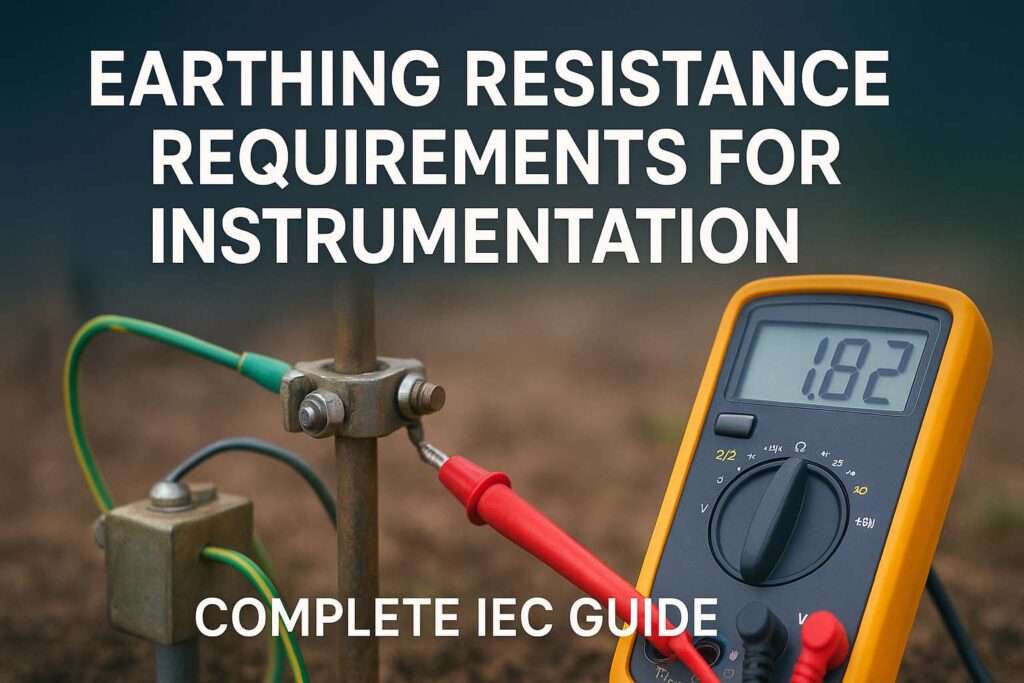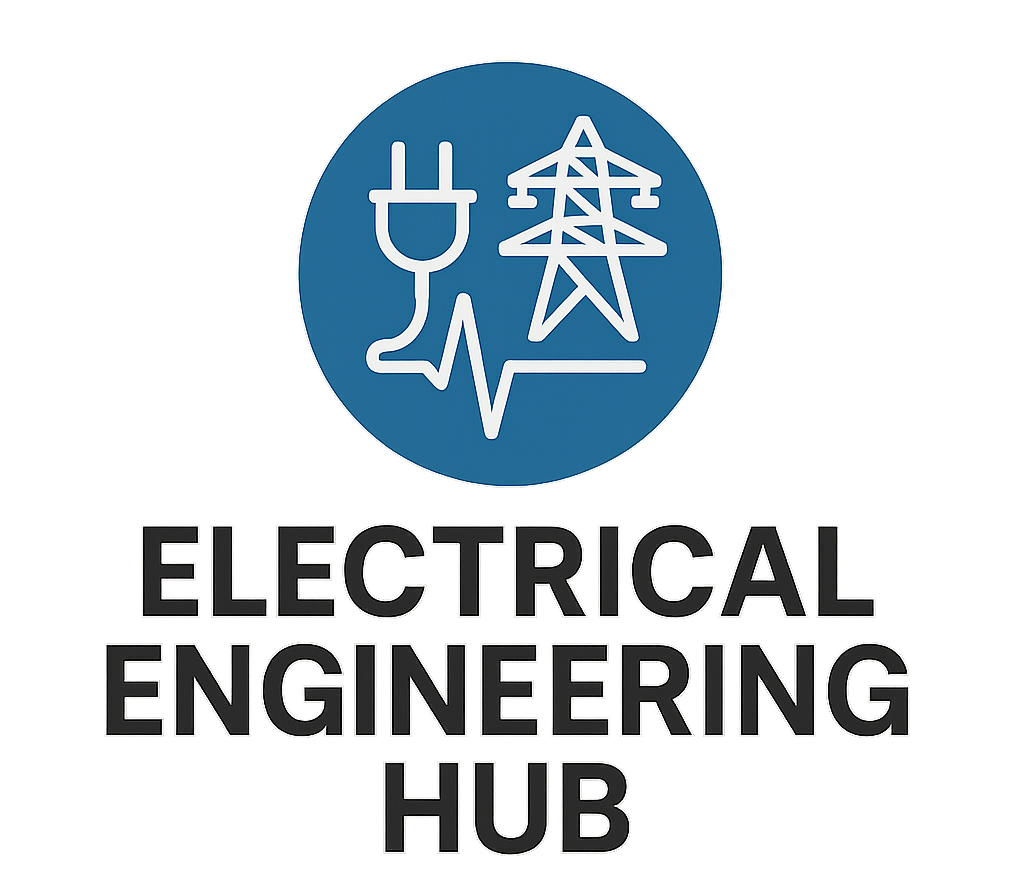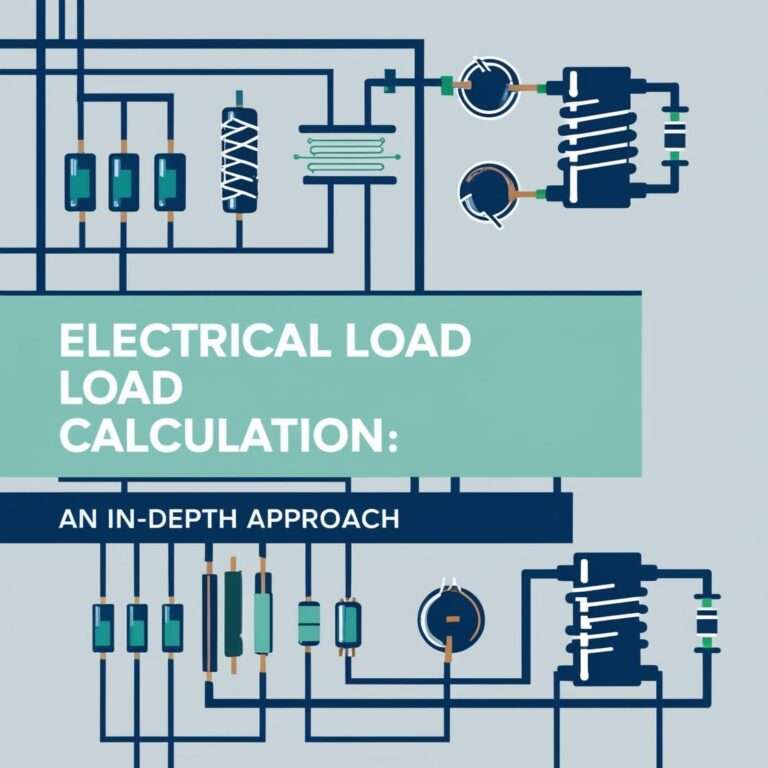Earthing Resistance Requirements for Instrumentation – Complete IEC Guide
Earthing is critical for ensuring the safety and accuracy of instrumentation systems. It provides a low-resistance path for fault currents and protects sensitive equipment from electrical surges. Improper earthing can lead to inaccurate measurements, signal interference, or even catastrophic equipment failure. This is why earthing resistance IEC guidelines are essential for industrial installations, especially in process control, automation, and power plants.
Table of Contents
Table of Contents

Instrumentation systems use low-level signals, often in the millivolt or milliamp range, which makes them highly susceptible to noise and ground loops. If the earthing resistance is too high, the system may develop potential differences that cause false readings or damage to sensitive devices. To avoid these issues, IEC standards provide clear recommendations on acceptable earth resistance values and best practices for design and testing.
Before we go into IEC-recommended values and methods, it’s important to understand that earthing is not just about safety but also about performance. A poorly designed earth system might meet basic safety requirements but fail to protect instrumentation accuracy.
Key Takeaways
- IEC recommends specific resistance values for earthing, typically less than 1 Ω for sensitive instrumentation systems.
- Factors like soil resistivity, moisture, and pit design affect earth resistance significantly.
- Proper earth pit design with multiple electrodes improves stability and compliance with IEC standards.
- Always test earthing resistance regularly to maintain performance and safety.
Know more about iec 60567
Why Earthing Resistance IEC Standards Matter
IEC standards exist to ensure uniformity and reliability across industries. For instrumentation, the primary focus is on signal integrity, noise suppression, and operator safety. If the resistance between the equipment ground and true earth is high, there is a greater chance of interference and potential hazards.
The standard IEC 60364 and IEC 60204-1 provide guidelines on protective and functional earthing. For instrumentation and control circuits, low-resistance grounding is critical because high-frequency noise, static charges, and fault currents can disrupt precise operations.
An effective grounding system ensures:
- Safe dissipation of fault currents.
- Stability of reference potential for signals.
- Protection of equipment and personnel.
For detailed compliance requirements, see our instrument earthing IEC standard guide that explains IEC rules in depth.
IEC Recommended Resistance Values for Instrumentation Earthing
IEC does not specify a single universal value for every system because requirements depend on application, soil conditions, and fault current levels. However, for sensitive systems like instrumentation, lower resistance is always better.
Below is a table summarizing typical recommended values:
| Application | Recommended Resistance (Ω) | Standard Reference |
|---|---|---|
| General Electrical Earthing | ≤ 10 Ω | IEC 60364 |
| Power System Main Earth | ≤ 1 Ω | IEC 60364-5-54 |
| Instrumentation & Control Systems | ≤ 1 Ω (preferably < 0.5 Ω) | IEC 60204-1, IEEE 142 |
| Sensitive Electronic Equipment | ≤ 0.5 Ω | IEC & IEEE Guidelines |
| Communication Systems | ≤ 1 Ω | IEC & ITU-T |
Know more about iec standard for battery charger
Why ≤ 1 Ω?
Instrumentation systems often require a stable zero-reference potential. A resistance above 1 Ω can create potential differences when fault or leakage currents flow, leading to noise and erratic readings.
Factors Affecting Earthing Resistance
Achieving a low earthing resistance is not always straightforward. Several physical and environmental factors influence the final value:
1. Soil Resistivity
Soil type plays a major role in determining earth resistance. Clay and loam soils usually have low resistivity, while rocky or sandy soils have high resistivity. IEC recommends measuring soil resistivity before designing the earthing system.
| Soil Type | Resistivity (Ω·m) |
|---|---|
| Clay (moist) | 20 – 100 |
| Loam | 50 – 300 |
| Sand | 200 – 1000 |
| Rocky Ground | >1000 |
Use our online tool prospective short circuit current calculator
2. Moisture Content
Water reduces soil resistivity. Dry conditions drastically increase resistance, which is why regular watering of earth pits is common in dry seasons.
3. Temperature
Frozen soil can increase resistance up to 10 times compared to normal conditions. This is critical in colder regions.
4. Electrode Design and Depth
The number of electrodes, their depth, and arrangement directly affect the resistance value. Deeper electrodes have more contact with moisture-rich soil, reducing resistance.
5. Chemical Treatment
Backfilling earth pits with bentonite, charcoal, or salt can improve conductivity, but IEC warns against aggressive chemicals that corrode electrodes.
Earth Pit Design per IEC for Instrumentation
A properly designed earth pit is the backbone of an effective grounding system. IEC recommends using multiple electrodes for low-resistance systems, especially when soil resistivity is high.
Basic Design Recommendations
- Electrode Material: Copper or copper-bonded steel rods for durability and conductivity.
- Electrode Size: Minimum diameter of 16 mm for copper rods, 20 mm for galvanized steel rods.
- Depth: Typically 2.5–3 m; deeper if soil resistivity is high.
- Number of Electrodes: Use multiple rods connected in parallel for better performance.
Example Earth Pit Arrangement:
- Install 3 copper rods of 3 m depth each.
- Space them at least twice their length apart (6 m apart).
- Interconnect rods with a copper strip or conductor.
Know more about fall of potential test
| Parameter | IEC Recommended Value |
|---|---|
| Rod Length | ≥ 2.5 m |
| Rod Diameter | ≥ 16 mm (copper) |
| Pit Size | 300 mm × 300 mm |
| Backfill Material | Bentonite/Charcoal mix |
Testing and Maintenance
IEC emphasizes periodic testing of earth resistance. Seasonal changes and corrosion can alter resistance over time. Recommended testing methods include:
- Fall-of-Potential Method (Three-Point Test)
- Clamp-On Earth Tester for live systems
Recommended Testing Frequency
- Every 6 months for critical systems.
- After any major maintenance or environmental change.
If resistance exceeds acceptable limits, add parallel electrodes or treat the soil with approved compounds.
Best Practices for Compliance with IEC
- Always design the system for < 1 Ω for instrumentation.
- Use corrosion-resistant materials to avoid deterioration.
- Keep earth conductors as short and straight as possible.
- Bond all equipment to a single grounding network to eliminate ground loops.
- Label and document earth pits for easy inspection.
Know more about Insulation Resistance Testing: Step-by-Step Process
Why Proper Earthing Ensures Instrumentation Accuracy
Instrumentation signals are small and easily affected by electrical noise. Without a solid ground reference, differential voltages can introduce errors in sensor readings. Moreover, transient surges from lightning or switching can damage equipment. Compliance with earthing resistance IEC standards ensures reliable readings and system stability.
For an in-depth discussion of IEC earthing principles and design, visit our instrument earthing IEC standard guide.
Conclusion
Earthing resistance for instrumentation is not just a safety requirement—it is a performance requirement. IEC guidelines provide a framework, but achieving a low-resistance ground often requires careful design and continuous monitoring. By understanding soil properties, optimizing pit design, and following IEC recommendations, you can ensure your instrumentation system operates reliably and accurately.
Summary Table – Quick Reference
| Aspect | IEC Recommendation |
|---|---|
| Resistance for Instrumentation | ≤ 1 Ω (preferably < 0.5 Ω) |
| Electrode Material | Copper or Copper-bonded Steel |
| Minimum Rod Depth | 2.5–3 m |
| Testing Frequency | Every 6 months |
What is the resistance of IEC standard earthing?
IEC recommends that the earth resistance for protective earthing should generally be less than 1 Ω for substations and less than 5 Ω for standard installations, depending on system design and soil conditions.
What is the resistance required for earthing?
The required earthing resistance varies by application, but typically 1–5 Ω is acceptable for electrical installations, while sensitive systems may require ≤1 Ω for safety and performance.
What is the IEC code for earthing?
The IEC code governing earthing and grounding systems is IEC 60364, which provides detailed guidelines for low-voltage electrical installations and protective earthing.
How do you calculate IEC earthing?
IEC recommends calculating earthing resistance using soil resistivity (ρ), electrode length (L), and diameter (d) with the formula:
What is the IEC standard for neutral earthing resistor?
The IEC standard for neutral earthing resistors is IEC 60071 and IEC 60076-25, which specify design, insulation coordination, and safety requirements for NER systems.
What is the IEC 60364 standard?
IEC 60364 is the international standard for low-voltage electrical installations, covering design, protection, earthing arrangements, and safety requirements to prevent electric shocks and faults.
Follow Us on Social:
Subscribe our Newsletter on Electrical Insights for latest updates from Electrical Engineering Hub
#EarthingResistance, #InstrumentationEarthing, #IECStandards, #ElectricalSafety, #GroundingSystem, #IndustrialAutomation, #InstrumentationSafety, #EarthingRequirements, #ElectricalEngineering, #PowerSystemSafety, #IEC60364, #GroundingStandards, #ElectricalCompliance, #InstrumentationDesign, #SafeGrounding






